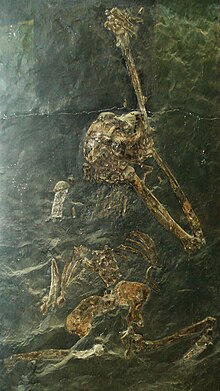| Oreopithecus Temporal range: Miocene
| |
|---|---|

| |
| Oreopithecus bambolii fossil | |
| Scientific classification | |
| Domain: | Eukaryota |
| Kingdom: | Animalia |
| Phylum: | Chordata |
| Class: | Mammalia |
| Order: | Primates |
| Suborder: | Haplorhini |
| Infraorder: | Simiiformes |
| Superfamily: | Hominoidea |
| Genus: | †Oreopithecus Gervais, 1872 |
| Type species | |
| Oreopithecus bambolii Gervais, 1872
| |
Oreopithecus (from the Greek ὄρος, oros and πίθηκος, pithekos, meaning "hill-ape") is an extinct genus of hominoid primate from the Miocene epoch whose fossils have been found in today's Tuscany and Sardinia in Italy.[1] It existed nine to seven million years ago in the Tusco-Sardinian area when this region was an isolated island in a chain of islands stretching from central Europe to northern Africa in what was becoming the Mediterranean Sea.[a]
Oreopithecus was one of many European immigrants that settled this area in the Vallesian–Turolian transition and one of few hominoids, together with Sivapithecus in Asia, to survive the so-called Vallesian Crisis.[2] To date, dozens of individuals have been discovered at the Tuscan localities of Montebamboli, Montemassi, Casteani, Ribolla, and, most notably, in the fossil-rich lignite mine in the Baccinello Basin,[2] making it one of the best-represented fossil apes.
- ^ Osbourne, Hannah (23 December 2019). "Strange swamp-dwelling prehistroic ape that counldn't walk on two legs or climb trees poses evolutionary puzzle". Newsweek. Retrieved 23 December 2019.
- ^ a b Agustí & Antón 2002, pp. Prefix ix, 174–175, 193, 197–199
Cite error: There are <ref group=lower-alpha> tags or {{efn}} templates on this page, but the references will not show without a {{reflist|group=lower-alpha}} template or {{notelist}} template (see the help page).
